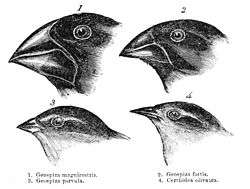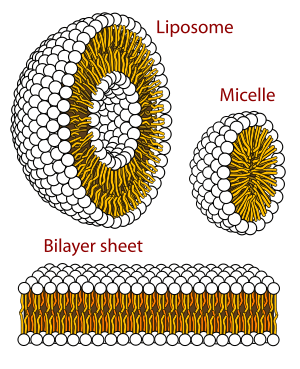Jeewanu
Jeewanu (Sanskrit for "particles of life") are synthetic chemical particles that possess cell-like structure and seem to have some functional properties; that is, they are a model of primitive cells, or protocells.[1][2][3] It was first synthesised by Krishna Bahadur (20 January 1926 — 5 August 1994), an Indian chemist and his team in 1963.[4][5][6] Using photochemical reaction, they produced coacervates, microscopic cell-like spheres from a mixture of simple organic and inorganic compounds. Bahadur named these particles 'Jeewanu' because they exhibit some of the basic properties of a cell, such as the presence of semipermeable membrane, amino acids, phospholipids and carbohydrates. Further, like living cells, they had several catalytic activities.[1] Jeewanu are cited as models of protocells for the origin of life,[7][8] and as artificial cells.[1]
| Part of a series on |
| Evolutionary biology |
|---|
 |
|
Key topics |
|
Fields and applications
|
|
Social implications
|
|
Etymology
Jeewanu is derived from Sanskrit jeewa, meaning "life", and anu, meaning the "smallest part of something", or the "indivisible". In contemporary Hindi, jeewanu also means unicellular organisms such as bacteria. Bahadur specifically used the term to represent the Indian philosophical tradition not only through the use of Sanskrit but also by inferring ideas on the origin of life from the Vedas. Bahadur, while employing the traditional Hindu philosophy, attempted to incorporate the advances in cell biology to the concept of abiogenesis.[1]
Synthesis

In 1954[9] and 1958 Krishna Bahadur and co-workers published the successful synthesis of amino acids from a mixture of paraformaldehyde, colloidal molybdenum oxide or potassium nitrate and ferric chloride under sunlight.[10] It appears that this experimental approach was seminal for the assays to produce Jeewanu, which he first reported in 1963 in an obscure Indian journal, Vijnana Parishad Anusandhan Patrika.[4] His detailed syntheses were published in Germany in 1964 in a series of articles.[11]
Their initial experiment consisted of a sterilised apparatus in which inorganic nitrogenous compounds (such as ammonium phosphate and ammonium molybdate) and organic compounds such as citric acid (C6H8O7), paraformaldehyde (OH(CH2O)nH) and formaldehyde (CH2O) for carbon sources were mixed with minerals commonly found in living cells.[2][12] Inorganic substances such as colloidal ferric chloride or molybdenum compounds supposedly acted as cofactors and catalysts.[1][10][13]
When the apparatus was exposed to sunlight for several days and constantly shaken, microscopic spherical particles were formed. The interesting features of these particles were that they were enclosed in a semipermeable membrane, like the typical cell membrane. Like living cells, they were reported to contain amino acids, phospholipid membrane and carbohydrates.[2][14][15] In addition, they were claimed to have reproductive capability by budding, much like unicellular organisms, but did not grow on any bacterial culture medium.[2] Bahadur reported that the Jeewanu exhibited various catalytic properties and produced their own peptides by metabolic reactions.[2] Bahadur's later work on the Jeewanu also detected the presence of amino acids in peptide form and sugars in the form of ribose, deoxyribose, fructose and glucose, as well as nucleic acid bases (DNA and RNA building blocks) including adenine, guanine, cytosine, thymine and uracil.[2][16][17] Bahadur also reported having detected ATPase-like and peroxidase-like activity. Bahadur stated that by using molybdenum as a cofactor, the Jeewanu showed capability of reversible photochemical electron transfer, and released a gas mixture of oxygen and hydrogen at a 1:2 ratio.[2][13]
Scientific reviews
Bahadur's publications were ambivalently received, and the overall attention of the scientific community seemed limited since Krishna Bahadur and his co-workers reported that the Jeewanus are alive (a striking statement), the team changed the protocols frequently and documented them somewhat idiosyncratically.[1] Bahadur defined "living units" as '"[...] those which grow, multiply, and are metabolically active in a systematic, harmonious, and synchronized manner".[5][11] Then, NASA's Exobiology Division tasked two biologists in 1967 to review and evaluate the literature so far published by Krishna Bahadur (not to replicate the experiments) on the synthesis and characteristics of the Jeewanu.[11][18] The two NASA biologists did not debate whether these three criteria are an adequate definition of life, but whether the Jeewanu satisfy these criteria.[18] The NASA report concluded that "the evidence presented on these three points is on the whole unconvincing". The report also stated that the postulated existence of these living units has not been proved and "the nature and properties of the Jeewanu remains to be clarified."[18]
In the 1980s, the Hungarian chemist Tibor Gánti discussed the Jeewanu at length in his 'Chemoton theory' —an abstract model of autocatalytic chemical reactions— published first in Hungarian and translated into English in 2003.[1] In the context of self-organizing structures, Gánti considered the Jeewanu a promising model system to understand the origin and fundamentals of life, and one that had never received due attention.[7] In 2011, a German scientist stated that the Jeewanu story pertains to concepts of life, its beginnings, as well as possible artificially created cells.[1]
Experimental duplication work published in 2013 by Gupta and Rai reported that their size varies from 0.5 μ to 3.5 μ in diameter, growth from within, metabolic activities, and "the presence of RNA-like material."[12] The authors stated that the RNA-like material detected in the Jeewanu protocells support the RNA world hypothesis."[12][19]
See also
- Abiogenesis
- Artificial cell
- Emergence
- Endocytosis
- Endosymbiotic theory
- Entropy and life
- Evolutionary developmental biology
- Last universal ancestor
- Lipid bilayer characterization
- Lipid bilayer phase behavior
- Model lipid bilayer
- Protocell Circus – a film
- Pseudo-panspermia
References
- Grote, M (September 2011). "Jeewanu, or the 'particles of life'" (PDF). Journal of Biosciences. 36 (4): 563–570. doi:10.1007/s12038-011-9087-0. PMID 21857103. Archived (PDF) from the original on July 16, 2015.
- Krishna, Bahadur; Ranganayaki, S.; Folsome, Clair; Smith, Adolf (1980). A functional approach to the origin of life problem (PDF). Golden Jubilee Conmmemoration Volume. National Academy of Sciences, India.
- "Jeewanu – Introduction". Jeewanu. Retrieved 2014-03-22.
- Bahadur, K; et al. (1963). "Synthesis of Jeewanu, the units capable of growth, multiplication and metabolic activity". Vijnana Parishad Anusandhan Patrika. 9: 117–127.
- Bahadur, K (1974). "Photochemical formation of self-sustaining coacervates" (PDF). Proc Indian Natl Sci Acad. 39 (4): 455–467. PMID 1242552. Archived from the original (PDF) on 2013-10-19.
- Bahadur, K (1975). "Photochemical formation of self-sustaining coacervates". Zentral Bakteriol Parasitenkd Infektionskr Hyg. 130 (2): 211–218. doi:10.1016/S0044-4057(75)80076-1. PMID 1242552.
- Gànti, T (2003). Chemoton Theory: Theory of Living Systems. New York (US): Kluwer Academic/Plenum Publishers. p. 329. ISBN 9780306477850.
- Gánti, T. (2003) The Principles of Life, Oxford University Press. ISBN 9780198507260
- Bahadur, Krishna (12 June 1954). "Photosynthesis of Amino-Acids from Paraformaldehylde and Potassium Nitrate". Nature. 173 (4415): 1141. Bibcode:1954Natur.173.1141B. doi:10.1038/1731141a0.
- Bahadur, K; Ranganayaki, S; Santamaria, L (1958). "Photosynthesis of amino-acids from paraformaldehyde involving the fixation of nitrogen in the presence of colloidal molybdenum oxide as catalyst". Nature. 182 (4650): 1668. Bibcode:1958Natur.182.1668B. doi:10.1038/1821668a0. PMID 13622608.
-
- 1) Bahadur, Krishna; Ranganayaki, S (1964). "Synthesis of Jeewanu, the Units Capable of Growth, Multiplication and Metabolic Activity. I. Preparation of Units Capable of Growth and Division and Having Metabolic Activity". Zentr. Bakteriol. Parasitenk. 117 (11): 367–5740.
- 2) Bahadur, K.; Verma, H. C.; Srivastva, R. B.; Agrawal, K. M. L.; Pandey, R. S.; Saxena, I.; Malviya, A. N.; Kumar, Vinod; Perti, 0. N.; Pathak, H. D. (1964). "Synthesis of Jeewanu, the Units Capable of Growth, Multiplication and Metabolic Activity. II. Photochemical Preparation of Growing and Multiplying Units with Metabolic Activities". Zentr. Bakteriol. Parasitenk. 117 (11): 573–584.
- 3) Bahadur, Krishna (1964). "Synthesis of Jeewanu, the Units Capable of Growth, Multiplication and Metabolic Activity. III. Preparation of Microspheres Capable of Growth and Division by Budding and Having Metabolic Activity with Peptides Prepared Thermally". Zentr. Bakteriol. Parasitenk. 117 (11): 585–602.
- 4) Bahadur, Krishna (1964). "Conversion of Lifeless Matter into the Living System". Zentr. Bakteriol. Parasitenk. 118 (11): 671–694.
- 5) Bahadur, Krishna (January 1965). "About a Few Experiments on Preparation of Jeewanu from Thermal Peptides". Agra Univ. J. Res. 14 (I): 41–48.
- 6) Bahadur, Krishna (1966). "Synthesis of Jeewanu the Protocell". Ram Narain Lal Beni Prasad. Allahabad, India. 121 (3): 291–319. PMID 4878619.
- Gupta, Vinod Kumar; Rai, R. K. (2013). "Histochemical localisation of RNA-like material in photochemically formed self-sustaining, abiogenic supramolecular assemblies 'Jeewanu'". Int. Res. J. Of Science & Engineering. 1 (1): 1–4. ISSN 2322-0015.
- Srivastava, Deepa (2016). "Effect of Irradiation of the PEM of 1.531211SMJ29 Jeewanu with Clinical Mercury Lamp and Sunlight on the Morphological Features of the Silicon Molybdenum Jeewanu" (PDF). International Journal of Engineering Research and General Science. 4 (4). ISSN 2091-2730.
- Bahadur, Krishna (June 1973), "Photochemical Formation of Self Sustaining Coacervates", 4th International Symposium of 'Origin of Life on the Earth', Barcelona, Spain
- Bahadur, Krishna (1975). "Photochemical Formation of Self Sustaining Coacervates". Zentral Bakteriol Parasitenkd Infektionskr. 130 (6): 211–218. doi:10.1016/s0044-4057(75)80076-1. PMID 1242552.
- Varma, P. K. (1981). "Histochemical study of lipid-like material in photochemically formed Jeewanu, the photocell, with formaldehyde partially replaced by other organic sources". Journal of the British Interplanetary Society. 34: 100–102. Bibcode:1981JBIS...34..100B.
- Gupta, VK (22 March 2002). "Matter contrives to be alive". Frontier Perspectives. Farlex, Inc.
- Caren, Linda D.; Ponnamperuma, Cyril (1967). "A review of some experiments on the synthesis of 'Jeewanu'" (PDF). NASA Technical Memorandum X-1439. Moffett Field, California: Ames Research Center.
- Kumar Gupta, Vinod; Chaturvedi, Indira (2013). "Histochemical characterization of protocell-like supramolecular assemblies "Jeewanu", synthesized in a irradiated sterilized aqueous mixture of some inorganic and organic substances" (PDF). Asian J. Exp. Sci. 27 (2): 23–28.
Books
- "Synthesis of Jeewanu, the Protocell." Bahadur, Krishna. (In English) Ram Narain Lal Beni Prasad, New Katra, Allahabad-211002 (U.P) India. ASIN: B0007JHWU0 (1966)
- "Origin of Life: A Functional Approach." Bahadur K. and Ranganayaki S.Ram Narain Lal Beni Prasad, New Katra, Allahabad-211002(U.P), India, (1981)
External links
- jeewanu.com Dr. Krishna Bahadur's homepage.